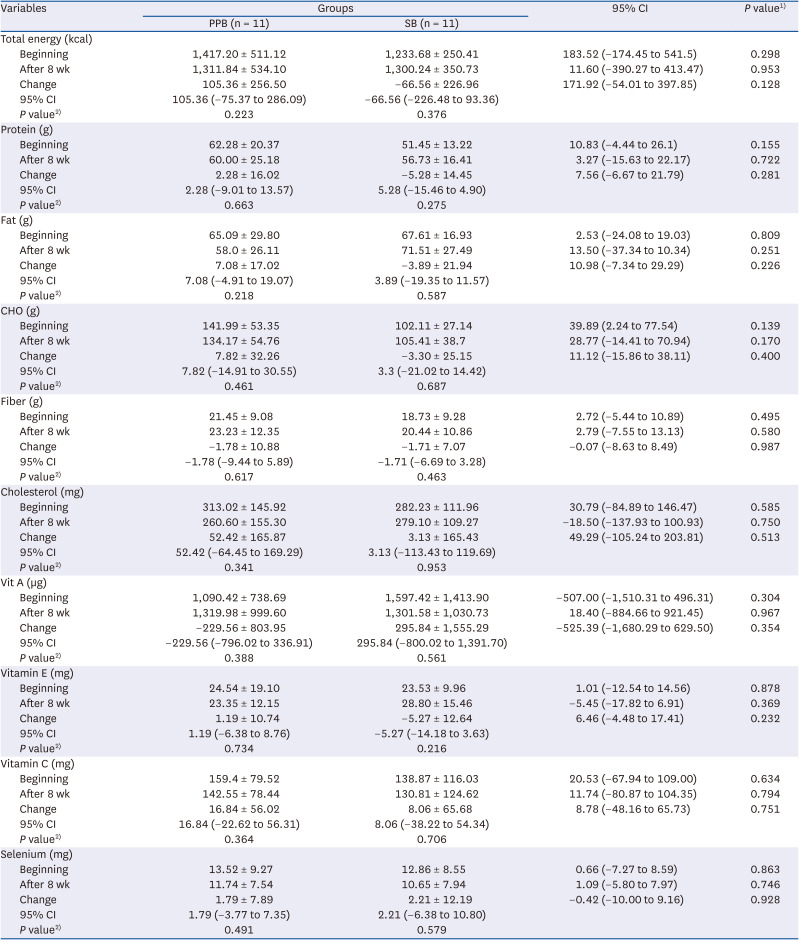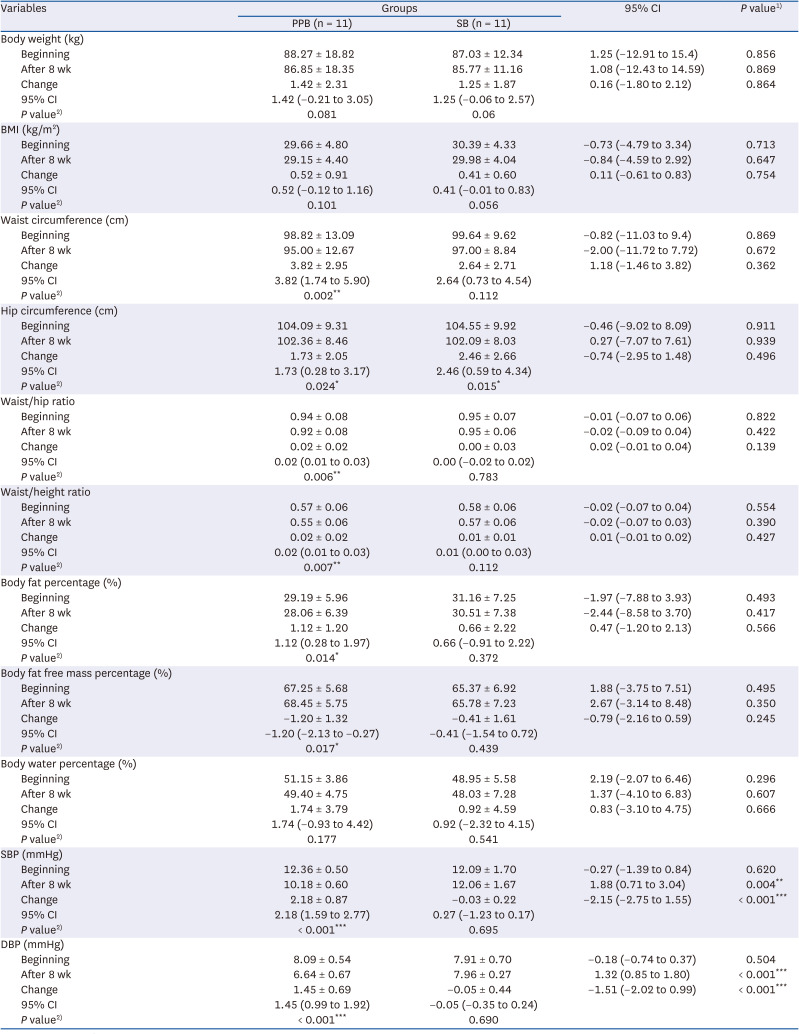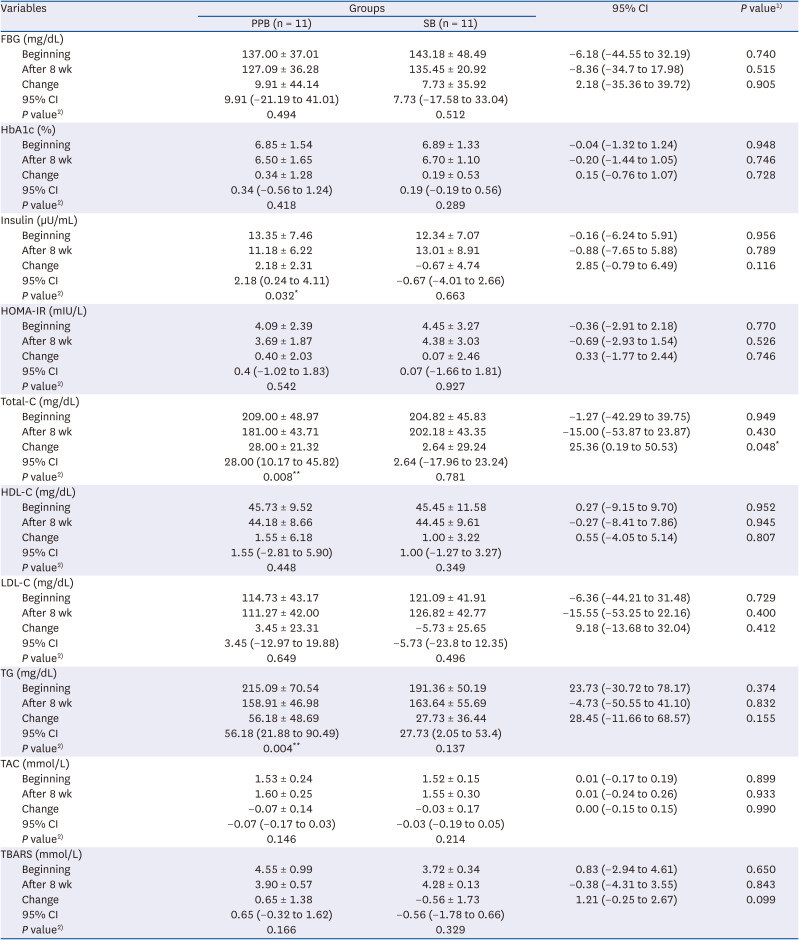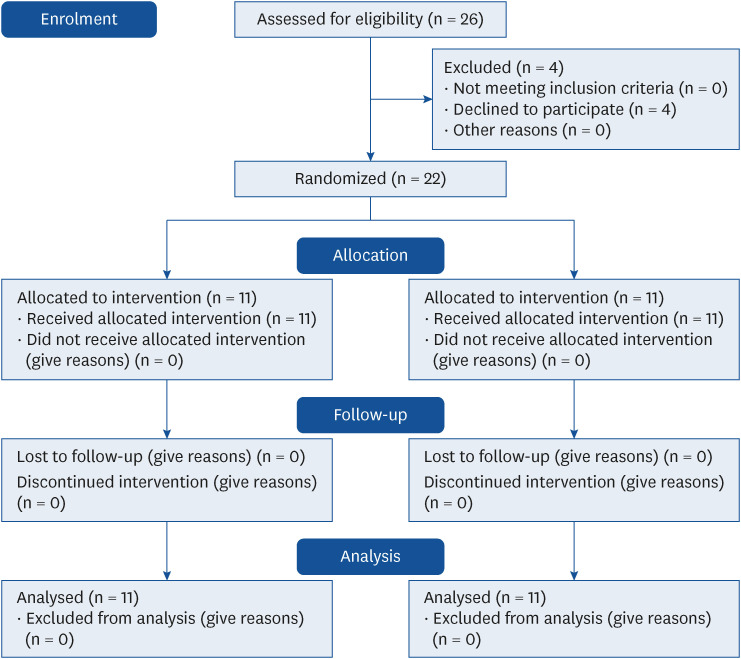2. Banihani S, Swedan S, Alguraan Z. Pomegranate and type 2 diabetes. Nutr Res. 2013; 33:341–348. PMID:
23684435.

3. Lewis GF, Carpentier A, Adeli K, Giacca A. Disordered fat storage and mobilization in the pathogenesis of insulin resistance and type 2 diabetes. Endocr Rev. 2002; 23:201–229. PMID:
11943743.

4. Kyrou I, Tsigos C. Obesity in the elderly diabetic patient: is weight loss beneficial? Diabetes Care. 2009; 32(Suppl 2):S403–S409. PMID:
19875589.
5. Williams K, Tchernof A, Hunt KJ, Wagenknecht LE, Haffner SM, Sniderman AD. Diabetes, abdominal adiposty, and atherogenic dislipoproteinemia in women compared with men. Diabetes. 2008; 57:3289–3296. PMID:
18809621.

6. Parhofer KG. Interaction between glucose and lipid metabolism: more than diabetic dyslipidemia. Diabetes Metab J. 2015; 39:353–362. PMID:
26566492.

7. Preedy RV. Diabetes: Oxidative stress and dietary antioxidants. Preddy VR, editor. Diabetes: Oxidative Stress and Dietary Antioxidants. London: Academic Press;2020. p. 36–41.
8. Green M, Arora K, Prakash S. Microbial Medicine: Prebiotic and probiotic functional foods to target obesity and metabolic syndrome. Int J Mol Sci. 2020; 21:2890. PMID:
32326175.

9. Grabež M, Škrbić R, Stojiljković MP, Rudić-Grujić V, Paunović M, Arsić A, Petrovic S, Vucic V, Mirjanic-Azaric B, Savikin K, et al. Beneficial effects of pomegranate peel extract on plasma lipid profile, fatty acids levels and blood pressure in patients with diabetes mellitus type-2: a randomized, double-blind, placebo-controlled study. J Funct Foods. 2020; 64:103692.

10. Viuda-Martos M, Fernández-López J, Pérez-Álvarez JA. Pomegranate and its many functional components as related to human health: a review. Compr Rev Food Sci Food Saf. 2010; 9:635–654. PMID:
33467822.

11. Çam M, İçyer NC, Erdoğan F. Pomegranate peel phenolics: Microencapsulation, storage stability and potential ingredient for functional food development. Lebensm Wiss Technol. 2014; 55:117–123.

12. Akhtar S, Ismail T, Fraternale D, Sestili P. Pomegranate peel and peel extracts: chemistry and food features. Food Chem. 2015; 174:417–425. PMID:
25529700.

13. Singh RP, Chidambara Murthy KN, Jayaprakasha GK. Studies on the Antioxidant activity of pomegranate (
Punicagranatum) peel and seed extracts using
in vitro models. J Agric Food Chem. 2002; 50:81–86. PMID:
11754547.

14. Naveena BM, Sen AR, Vaithiyanathan S, Babji Y, Kondaiah N. Comparative efficacy of pomegranate juice, pomegranate rind powder extract and BHT as antioxidants in cooked chicken patties. Meat Sci. 2008; 80:1304–1308. PMID:
22063872.

15. Kanatt SR, Chander R, Sharma A. Antioxidant and antimicrobial activity of pomegranate peel extract improves the shelf life of chicken products. Int J Food Sci Technol. 2010; 45:216–222.

16. Jakobek L. Interactions of polyphenols with carbohydrates, lipids and proteins. Food Chem. 2015; 175:556–567. PMID:
25577120.

17. Aviram M, Dornfeld L, Rosenblat M, Volkova N, Kaplan M, Coleman R, Hayek T, Presser D, Fuhrman B. Pomegranate juice consumption reduces oxidative stress, atherogenic modifications to LDL, and platelet aggregation: studies in humans and in atherosclerotic apolipoprotein E-deficient mice. Am J Clin Nutr. 2000; 71:1062–1076. PMID:
10799367.

19. Rakıcıoğlu NT, Ayaz A, Pekcan G. Food and Food Photo Catalogue, Sizes and Quantities. Ankara: Nadir Press;2012.
20. Merdol TK. Standard Food Recipes for Instituons With Mass Nutrition. Ankara: Hatipoğlu Press;2003.
21. Schmind M. Beslenme Bilgi Sistemi BEBİS 8.2 Paket program [Internet]. Struttgart: Entwickelt an der Universital Hohenheim;2011. cited 2022 February 10. Available from:
https://www.bebis.com.tr.
22. Pekcan G. Determination of nutritional status. Baysal A, Aksoy M, Besler T, editors. Diet Handbook. Ankara: Hatipoğlu Press;2013. p. 67–141.
23. Ashwell M, Gibson S. Waist-to-height ratio as an indicator of ‘early health risk’: simpler and more predictive than using a ‘matrix’ based on BMI and waist circumference. BMJ Open. 2016; 6:e010159.

24. Grabež M, Škrbić R, Stojiljković MP, Vučić VM, Grujić VR, Jakovljević V, Djuric DM, Surucic R, Savikin K, Bigovic D, et al. A prospective, randomized, double-blind, placebo-controlled trial of polyphenols on the outcomes of inflammatory factors and oxidative stress in patients with type 2 diabetes mellitus. Rev Cardiovasc Med. 2022; 23:57. PMID:
35229548.

25. El-Hadary AE, Ramadan MF. Phenolic profiles, antihyperglycemic, antihyperlipidemic, and antioxidant properties of pomegranate (
Punica granatum) peel extract. J Food Biochem. 2019; 43:e12803. PMID:
31353600.
26. Singh B, Singh JP, Kaur A, Singh N. Phenolic compounds as beneficial phytochemicals in pomegranate (
Punica granatum L.) peel: a review. Food Chem. 2018; 261:75–86. PMID:
29739608.

27. Guil-Guerrero JL, Ramos L, Moreno C, Zúñiga-Paredes JC, Carlosama-Yepez M, Ruales P. Plant foods by-products as sources of health-promoting agents for animal production: a review focusing on the tropics. Agron J. 2016; 108:1759–1774.

28. Dietary Reference Intakes for Vitamin C. Vitamin E, Selenium, and Carotenoids. Washington DC: National Academies Press;2000. p. 35–58.
29. Yoon JH, Baek SJ. Molecular targets of dietary polyphenols with anti-inflammatory properties. Yonsei Med J. 2005; 46:585–596. PMID:
16259055.

30. Amato MC, Guarnotta V, Giordano C. Body composition assessment for the definition of cardiometabolic risk. J Endocrinol Invest. 2013; 36:537–543. PMID:
23612318.
31. Luo W, Guo Z, Hu X, Zhou Z, Wu M, Zhang L, Liu J. 2 years change of waist circumference and body mass index and associations with type 2 diabetes mellitus in cohort populations. Obes Res Clin Pract. 2013; 7:e290–e296. PMID:
24306157.

32. Azizi-Soleiman F, Khoshhali M, Heidari-Beni M, Qorbani M, Kelishadi R. Association between dietary antioxidant quality score and anthropometric measurements in children and adolescents: The weight disorders survey of the CASPIAN-IV Study. J Trop Pediatr. 2021; 67:fmaa065. PMID:
32844219.

33. Vincent HK, Taylor AG. Biomarkers and potential mechanisms of obesity-induced oxidant stress in humans. Int J Obes (Lond). 2006; 30:400–418. PMID:
16302012.

34. Puchau B, Ochoa MC, Zulet MA, Marti A, Martínez JA, Members G. Dietary total antioxidant capacity and obesity in children and adolescents. Int J Food Sci Nutr. 2010; 61:713–721. PMID:
20528580.

35. Hermsdorff HH, Puchau B, Volp AC, Barbosa KB, Bressan J, Zulet MÁ, Martínez JA. Dietary total antioxidant capacity is inversely related to central adiposity as well as to metabolic and oxidative stress markers in healthy young adults. Nutr Metab (Lond). 2011; 8:59. PMID:
21859453.

36. Yadav A, Kumari R, Yadav A, Mishra JP, Srivastava S, Prabha S. Antioxidants and its functions in human body: a review. Res Environ Life Sci. 2016; 9:1328–1331.
37. Rampersaud GC, Valim MF. 100% citrus juice: nutritional contribution, dietary benefits, and association with anthropometric measures. Crit Rev Food Sci Nutr. 2017; 57:129–140. PMID:
25831042.

38. Bhargava A. Fiber intakes and anthropometric measures are predictors of circulating hormone, triglyceride, and cholesterol concentrations in the women’s health trial. J Nutr. 2006; 136:2249–2254. PMID:
16857849.

39. Järvi A, Karlström B, Vessby B, Becker W. Increased intake of fruits and vegetables in overweight subjects: effects on body weight, body composition, metabolic risk factors and dietary intake. Br J Nutr. 2016; 115:1760–1768. PMID:
26996228.

40. Velázquez-López L, Santiago-Díaz G, Nava-Hernández J, Muñoz-Torres AV, Medina-Bravo P, Torres-Tamayo M. Mediterranean-style diet reduces metabolic syndrome components in obese children and adolescents with obesity. BMC Pediatr. 2014; 14:175. PMID:
24997634.

41. Al-Muammar MN, Khan F. Obesity: the preventive role of the pomegranate (
Punica granatum). Nutrition. 2012; 28:595–604. PMID:
22342388.

42. Hosseini B, Saedisomeolia A, Wood LG, Yaseri M, Tavasoli S. Effects of pomegranate extract supplementation on inflammation in overweight and obese individuals: A randomized controlled clinical trial. Complement Ther Clin Pract. 2016; 22:44–50. PMID:
26850805.

43. González-Ortiz M, Martínez-Abundis E, Espinel-Bermúdez MC, Pérez-Rubio KG. Effect of pomegranate juice on insulin secretion and sensitivity in patients with obesity. Ann Nutr Metab. 2011; 58:220–223. PMID:
21811060.

44. van der Schaft N, Trajanoska K, Rivadeneira F, Ikram MA, Schoufour JD, Voortman T. Total dietary antioxidant capacity and longitudinal trajectories of body composition. Antioxidants (Basel). 2020; 9:728. PMID:
32785027.

45. Singh RP, Chidambara Murthy KN, Jayaprakasha GK. Studies on the antioxidant activity of pomegranate (
Punica granatum) peel and seed extracts using
in vitro models. J Agric Food Chem. 2002; 50:81–86. PMID:
11754547.

46. Asgary S, Sahebkar A, Afshani MR, Keshvari M, Haghjooyjavanmard S, Rafieian-Kopaei M. Clinical evaluation of blood pressure lowering, endothelial function improving, hypolipidemic and anti-inflammatory effects of pomegranate juice in hypertensive subjects. Phytother Res. 2014; 28:193–199. PMID:
23519910.

47. Stockton A, Farhat G, McDougall GJ, Al-Dujaili EA. Effect of pomegranate extract on blood pressure and anthropometry in adults: a double-blind placebo-controlled randomised clinical trial. J Nutr Sci. 2017; 6:e39. PMID:
29152243.

48. Aleixandre A, Miguel M. Dietary fiber and blood pressure control. Food Funct. 2016; 7:1864–1871. PMID:
26923351.

49. Francis GA, Annicotte JS, Auwerx J. PPAR agonists in the treatment of atherosclerosis. Curr Opin Pharmacol. 2003; 3:186–191. PMID:
12681242.

50. Makino-Wakagi Y, Yoshimura Y, Uzawa Y, Zaima N, Moriyama T, Kawamura Y. Ellagic acid in pomegranate suppresses resistin secretion by a novel regulatory mechanism involving the degradation of intracellular resistin protein in adipocytes. Biochem Biophys Res Commun. 2012; 417:880–885. PMID:
22206671.

51. Chandalia M, Garg A, Lutjohann D, von Bergmann K, Grundy SM, Brinkley LJ. Beneficial effects of high dietary fiber intake in patients with type 2 diabetes mellitus. N Engl J Med. 2000; 342:1392–1398. PMID:
10805824.

52. Sohrab G, Nasrollahzadeh J, Zand H, Amiri Z, Tohidi M, Kimiagar M. Effects of pomegranate juice consumption on inflammatory markers in patients with type 2 diabetes: A randomized, placebo-controlled trial. J Res Med Sci. 2014; 19:215–220. PMID:
24949028.
53. Bonneau GA, Pedrozo WR, Berg G. Adiponectin and waist circumference as predictors of insulin-resistance in women. Diabetes Metab Syndr. 2014; 8:3–7. PMID:
24661750.

54. Sarwar N, Gao P, Seshasai SR, Gobin R, Kaptoge S, Di Angelantonio E, Ingelsson E, Lawror DA, Selvin E, Stampfer E, et al. Diabetes mellitus, fasting blood glucose concentration, and risk of vascular disease: a collaborative meta-analysis of 102 prospective studies. Lancet. 2010; 375:2215–2222. PMID:
20609967.
55. Abdel-Rahim E, El-Beltagi H, Romela R. White bean seeds and Pomegranate peel and fruit seeds as hypercholesterolemic and hypolipidemic agents in albino rats. Grasas Aceites. 2013; 64:50–58.
56. Rosenblat M, Aviram M. Pomegranate juice protects macrophages from triglyceride accumulation: inhibitory effect on DGAT1 activity and on triglyceride biosynthesis. Ann Nutr Metab. 2011; 58:1–9.
57. Lv O, Wang L, Li J, Ma Q, Zhao W. Effects of pomegranate peel polyphenols on lipid accumulation and cholesterol metabolic transformation in L-02 human hepatic cells via the PPARγ-ABCA1/CYP7A1 pathway. Food Funct. 2016; 7:4976–4983. PMID:
27845788.

58. Hontecillas R, Diguardo M, Duran E, Orpi M, Bassaganya-Riera J. Catalpic acid decreases abdominal fat deposition, improves glucose homeostasis and upregulates PPAR α expression in adipose tissue. Clin Nutr. 2008; 27:764–772. PMID:
18778878.
59. Jang A, Srinivasan P, Lee NY, Song HP, Lee JW, Lee M, Jo C. Comparison of hypolipidemic activity of synthetic gallic acid-linoleic acid ester with mixture of gallic acid and linoleic acid, gallic acid, and linoleic acid on high-fat diet induced obesity in C57BL/6 Cr Slc mice. Chem Biol Interact. 2008; 174:109–117. PMID:
18571153.

60. Sahebkar A, Simental-Mendia LE, Giorgini P, Ferri C, Grassi D. Lipid profile changes after pomegranate consumption: a systematic review and meta-analysis of randomized controlled trials. Phytomedicine. 2016; 23:1103–1112. PMID:
26857863.
61. Grassi D, Desideri G, Ferri L, Tiberti S, Ferri C. Cocoa and lipid profile: a fat paradox? Agro Food Ind Hi Tech. 2009; 20:23–25.
62. Guo C, Wei J, Yang J, Xu J, Pang W, Jiang Y. Pomegranate juice is potentially better than apple juice in improving antioxidant function in elderly subjects. Nutr Res. 2008; 28:72–77. PMID:
19083391.
63. Petrovic S, Arsic A, Glibetic M, Cikiriz N, Jakovljevic V, Vucic V. The effects of polyphenol-rich chokeberry juice on fatty acid profiles and lipid peroxidation of active handball players: results from a randomized, double-blind, placebo-controlled study. Can J Physiol Pharmacol. 2016; 94:1058–1063. PMID:
27322521.

64. Kojadinovic MI, Arsic AC, Debeljak-Martacic JD, Konic-Ristic AI, Kardum ND, Popovic TB, Glibetic MD. Consumption of pomegranate juice decreases blood lipid peroxidation and levels of arachidonic acid in women with metabolic syndrome. J Sci Food Agric. 2017; 97:1798–1804. PMID:
27476699.
65. Ardekani MR, Hajimahmoodi M, Oveisi MR, Sadeghi N, Jannat B, Ranjbar AM, Gholam N, Moridi T. Comparative antioxidant activity and total flavonoid content of Persian pomegranate (
Punica granatum L.) cultivars. Iran J Pharm Res. 2011; 10:519–524. PMID:
24250384.
66. Tehranifar A, Selahvarzi Y, Kharrazi M, Bakhsh VJ. High potential of agro-industrial by-products of pomegranate (
Punica granatum L.) as the powerful antifungal and antioxidant substances. Ind Crops Prod. 2011; 34:1523–1527.

67. López-Marcos MC, Bailina C, Viuda-Martos M, Pérez-Alvarez JA, Fernández-López J. Properties of dietary fibers from agroindustrial coproducts as source for fiber-enriched foods. Food Bioprocess Technol. 2015; 8:2400–2408.

68. Xu X, Zhang J, Zhang Y, Qi H, Wang P. Associations between dietary fiber intake and mortality from all causes, cardiovascular disease and cancer: a prospective study. J Transl Med. 2022; 20:344. PMID:
35918724.

69. Başlar M, Ertugay MF. Effect of ultrasound and photosonication treatment on polyphenoloxidase (PPO) activity, total phennolic component and colour of apple juice. Int J Food Sci Technol. 2013; 48:886–892.

70. Topçu B, Caba ZT, Erdil DN. Effect of oat bread production stages on phenolic content and antioxidant activity. Food Health. 2019; 5:48–63.
71. Sablani SS, Marcotte M, Baik OD, Castaigne F. Modeling of Simultaneous heat and water transport in the baking process. Lebensm Wiss Technol. 1998; 31:201–209.

72. Eliášová M, Kotíková Z, Lachman J, Orsák M, Martinek P. Influence of baking on anthocyanin content in coloured-grain wheat bread. Plant Soil Environ. 2020; 66:381–386.

73. Han HM, Koh BK. Antioxidant activity of hard wheat flour, dough and bread prepared using various processes with the addition of different phenolic acids. J Sci Food Agric. 2011; 91:604–608. PMID:
21302313.

74. Hobbs RJ, Higgs E, Hall CM, Bridgewater P, Chapin FS, Ellis EC, Ewel JJ, Hallett M, Harris J, Hulvey KB, et al. Managing the whole landscape: historical, hybrid, and novel ecosystems. Front Ecol Environ. 2014; 12:557–564.

75. Altunkaya A, Hedegaard RV, Brimer L, Gökmen V, Skibsted H. Antioxidant capacity versus chemical safety of wheat bread enriched with pomegranate peel powder. Food Funct. 2013; 4:722–727. PMID:
23429604.

76. Srivastava P, Indrani D, Singh RP. Effect of dried pomegranate (
Punica granatum) peel powder (DPPP) on textural, organoleptic and nutritional characteristics of biscuits. Int J Food Sci Nutr. 2014; 65:827–833. PMID:
25019979.










 PDF
PDF Citation
Citation Print
Print




 XML Download
XML Download